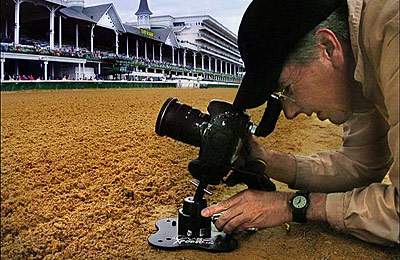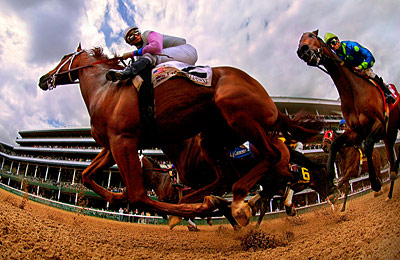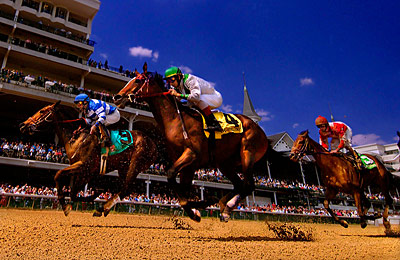Workshop at the Ranch – June 2005 – Remote Cameras at Churchill Downs
![]() Hi and welcome to the June issue of Workshop at the Ranch. If you have read the June issue of On The Road then you are aware that horse racing is my favorite sport to photograph, so I decided to continue the horse racing images I captured from Derby Week at Churchill Downs. The use of remote cameras is fast becoming more of a requirement for the sports photographer. A remote camera is often used in a location that the photographer cannot physically be in…example: under the inside rail at horse racing. Sometimes a remote camera is used to capture additional images…example: a floor remote at basketball might be located directly in front of me. The remote captures additional images with a different lens while I shoot with a hand held camera. I rarely use more than 2 remote cameras at any venue. Photographers like Skip Dickstein tend to use 10 or even more to cover the Kentucky Derby. Let’s take a look at some images I captured with remote cameras……..
Hi and welcome to the June issue of Workshop at the Ranch. If you have read the June issue of On The Road then you are aware that horse racing is my favorite sport to photograph, so I decided to continue the horse racing images I captured from Derby Week at Churchill Downs. The use of remote cameras is fast becoming more of a requirement for the sports photographer. A remote camera is often used in a location that the photographer cannot physically be in…example: under the inside rail at horse racing. Sometimes a remote camera is used to capture additional images…example: a floor remote at basketball might be located directly in front of me. The remote captures additional images with a different lens while I shoot with a hand held camera. I rarely use more than 2 remote cameras at any venue. Photographers like Skip Dickstein tend to use 10 or even more to cover the Kentucky Derby. Let’s take a look at some images I captured with remote cameras……..
Hi and welcome to the June issue of Workshop at the Ranch. If you have read the June issue of On The Road then you are aware that horse racing is my favorite sport to photograph, so I decided to continue the horse racing images I captured from Derby Week at Churchill Downs. The use of remote cameras is fast becoming more of a requirement for the sports photographer. A remote camera is often used in a location that the photographer cannot physically be in…example: under the inside rail at horse racing. Sometimes a remote camera is used to capture additional images…example: a floor remote at basketball might be located directly in front of me. The remote captures additional images with a different lens while I shoot with a hand held camera. I rarely use more than 2 remote cameras at any venue. Photographers like Skip Dickstein tend to use 10 or even more to cover the Kentucky Derby. Let’s take a look at some images I captured with remote cameras……..
|
|
|
Image #2 Here is the image I captured using the remote set up illustrated in the previous picture. I have chosen a location just before the first turn at the end of the front stretch. I used the Nikon D2X, ISO400, Shutter Priority 1/3200 at f5.6 EV-0.7, Nikon 10.5mm Fisheye Lens, Manual Focus, WB 6700K, Lexar 4G Flash Card. I left the image with the Fisheye perspective. I like the way the distortion wraps around the horse and jockey. Also take note that Manual Focus is being used….I manually pre focus on a “zone” or area where the horses will race through. I will need to take a burst of images as the horses enter the “zone” or “pre focused” area. This is commonly called “Zone Focus” or “Pre Focus” and is used when shooting with a remote camera. If I were shooting the finish line of the 100 meters at the Olympics with a remote camera, I would manually “zone focus” or “pre focus” on the finish line and shoot a burst of frames as the runners crossed the finish line. All these images are captured with Shutter Priority at a high shutter speed in order to freeze the action as the horses race by. I will dial down the EV compensation to EV-0.7. This takes into account that the horses are very dark and the Priority setting will try to record them as an 18% gray which will blow out the sky….so I dial down the EV in order to keep the exposure accurate. |
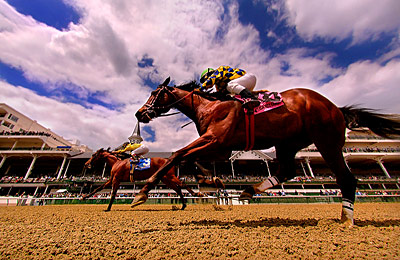 Image #3 Here is a frame using the same remote set up as the previous image except I have moved to a location directly across the track from the main Grandstands with the famous Spires of Churchill Downs. This time I corrected the 10.5mm Fisheye distortion in Nikon Capture. Same OverXposed Ground Plate, Slik Ball Head, N90M3-P Pre-Trigger cord from the camera to the Pocket Wizard Multi Max Transceiver. Nikon D2X, ISO400, Shutter Priority 1/3200 at f8 EV-0.7, Nikon 10.5mm Fisheye Lens, Manual Focus, WB 6700K, Lexar 4G Flash Card. These extremely high shutter speeds that I will use in all these images are required to freeze the action…remember this is a remote camera and I am not able to pan with the horses as they race by. I also use a high f stop to provide a large depth of field as the horses might be very close to the camera or across the track. Even though the sun is shining I will need to use a High ISO to achieve both these settings and take into account that the clouds might block the sun as the horses come by. The Nikon D2X at ISO400 produces a very clean noise free image. Image #3 Here is a frame using the same remote set up as the previous image except I have moved to a location directly across the track from the main Grandstands with the famous Spires of Churchill Downs. This time I corrected the 10.5mm Fisheye distortion in Nikon Capture. Same OverXposed Ground Plate, Slik Ball Head, N90M3-P Pre-Trigger cord from the camera to the Pocket Wizard Multi Max Transceiver. Nikon D2X, ISO400, Shutter Priority 1/3200 at f8 EV-0.7, Nikon 10.5mm Fisheye Lens, Manual Focus, WB 6700K, Lexar 4G Flash Card. These extremely high shutter speeds that I will use in all these images are required to freeze the action…remember this is a remote camera and I am not able to pan with the horses as they race by. I also use a high f stop to provide a large depth of field as the horses might be very close to the camera or across the track. Even though the sun is shining I will need to use a High ISO to achieve both these settings and take into account that the clouds might block the sun as the horses come by. The Nikon D2X at ISO400 produces a very clean noise free image. |
|
Image #4 This image is a more common remote position located under the inside rail just beyond the finish line. This was the first race of the day and started at 12 noon. I decided to use a polarizing filter to try and deepen the sky. Examination of the image leads me to believe this may no longer be necessary since the Nikon D2X has an advanced color engine and produces such beautiful color. The filter causes a two stop loss which forced me to use a higher ISO and slower shutter speed. Nevertheless, I gave it a try and was pleased with the results but probably would not use it again thanks to the D2X. Nikon D2X, ISO500, Shutter Priority 1/2000 at f5 EV-0.7, Nikon 17-55mm with a Polarize Filter, Manual Focus, WB 5600K, Lexar 4G Flash Card, and same remote plate, cord, Pocket Wizard etc. The 1/2000 shutter speed was barely enough to freeze the horses hoofs and flying dirt, but was fortunate enough to capture all three horses in “all fours” position (all four hoofs are off the ground.) |
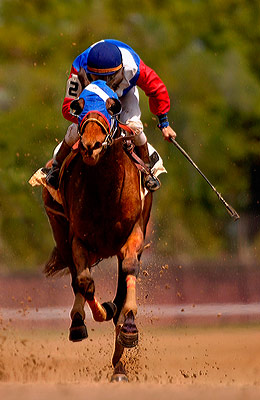 Image #5 This image is captured with a remote camera located in the same position as the previous image, just beyond the finish line. The difference is the use of a long lens instead of a short lens and my view is down the front stretch. For long lens remote work I use a larger OverXposed Ground Plate and a 3 1/2 inch tall post plus the Slik Pro Ball Head to raise the camera. This higher placement is just enough to see over someone else’s remote camera that is close to mine and to see over the dirt far down the race course. Nikon D2X, ISO400, Shutter Priority 1/2000 at f5 EV-0.7, Nikon 200-400mm G VR Zoom Lens set at 400mm, Dynamic Area Auto Focus mode, WB 6700K , Lexar 4G Flash Card, and the N90M3-P Pre-Release Cord from the camera to the Pocket Wizard. NOTE: With this long lens set up I would usually manually focus the lens on the area (“zone focus” or “pre focus”) where the horses would race through, but I decided to experiment and try the auto focus in the Dynamic Area Mode. It worked very well and as the horse entered the view of the camera the Dynamic Area sensor began tracking the horse and I captured 10 sharp frames as the horse advanced towards the finish line. I have done this before with horse racing and track events and I am always amazed at the accuracy of the Nikon Dynamic Area Mode of auto focus. Image #5 This image is captured with a remote camera located in the same position as the previous image, just beyond the finish line. The difference is the use of a long lens instead of a short lens and my view is down the front stretch. For long lens remote work I use a larger OverXposed Ground Plate and a 3 1/2 inch tall post plus the Slik Pro Ball Head to raise the camera. This higher placement is just enough to see over someone else’s remote camera that is close to mine and to see over the dirt far down the race course. Nikon D2X, ISO400, Shutter Priority 1/2000 at f5 EV-0.7, Nikon 200-400mm G VR Zoom Lens set at 400mm, Dynamic Area Auto Focus mode, WB 6700K , Lexar 4G Flash Card, and the N90M3-P Pre-Release Cord from the camera to the Pocket Wizard. NOTE: With this long lens set up I would usually manually focus the lens on the area (“zone focus” or “pre focus”) where the horses would race through, but I decided to experiment and try the auto focus in the Dynamic Area Mode. It worked very well and as the horse entered the view of the camera the Dynamic Area sensor began tracking the horse and I captured 10 sharp frames as the horse advanced towards the finish line. I have done this before with horse racing and track events and I am always amazed at the accuracy of the Nikon Dynamic Area Mode of auto focus. |
|
Image #6 Here is the first frame of a ten frame burst as the horses come out of the start gate. I used the same remote set up as the previous image, (Image#5), including auto focus in the Dynamic Area mode. Keep in mind this race was not assigned to be covered and was used as an opportunity to test my idea of using auto focus rather than manually pre focusing on a zone. Again, it worked well capturing 10 for 10 images in perfect focus. Nikon D2X, ISO400, Shutter Priority 1/2000 at f5 EV-0.7, Nikon 200-400mm G VR Zoom Lens, Dynamic Area Auto Focus mode, WB 6700K, Lexar 4G Flash Card, Large OverXposed Ground Plate with 3 1/2 inch post, Slik Pro Ball Head, N90M3-P Pre- Release Trigger cord from the camera to the Pocket Wizard. |
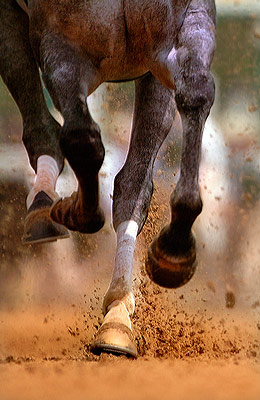 Image #7 This image is the final frame of the 10 frame burst. The Dynamic Area Auto Focus mode on the Nikon D2X worked perfectly. While my choice of using auto focus instead of manually pre focusing on a zone area of the race course worked well for these situations it might not be appropriate for all situations. For example, Skip pointed out that if the eventual winner passes on the outside of the pack (like Giacomo did to win the Kentucky Derby) the auto focus sensor would still be tracking the inside horse near the rail. That could leave you with several sharp images of the second place horse and none of the winner. Should you decide to use this method of auto focus rather than manually pre focusing on a zone area be aware of the possibilities both pro and con. Image #7 This image is the final frame of the 10 frame burst. The Dynamic Area Auto Focus mode on the Nikon D2X worked perfectly. While my choice of using auto focus instead of manually pre focusing on a zone area of the race course worked well for these situations it might not be appropriate for all situations. For example, Skip pointed out that if the eventual winner passes on the outside of the pack (like Giacomo did to win the Kentucky Derby) the auto focus sensor would still be tracking the inside horse near the rail. That could leave you with several sharp images of the second place horse and none of the winner. Should you decide to use this method of auto focus rather than manually pre focusing on a zone area be aware of the possibilities both pro and con. |
Well, that finishes another Workshop at the Ranch. I hope this information has been helpful to all of you. Remote cameras are very helpful. They are usually used as a means of capturing an image from a position not available to the photographer. Great action images can be captured this way, but it takes time, patience and the willingness to practice and experiment with your equipment in order to obtain great results. Find a small event and begin practicing. My thanks to Skip Dickstein for spending some time with me during the early races. Watching and learning from Skip was a real treat……..he is the jedi master of remotes.
See you next time at Workshop at the Ranch. Adios, Dave


